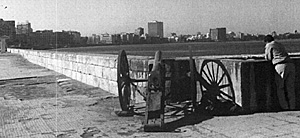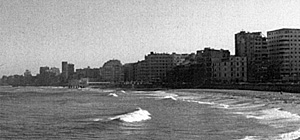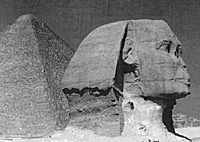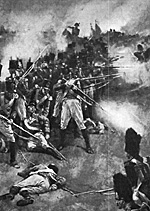Opportunity Target
Egypt 1798-1801
by Major J. W. Drage, RA
| |
As a Gunner officer, I am trained to look for opportunity targets However, they seldom arrive in such a juicy form as 4th Armoured Brigade's battlefield tour of Egypt in January. The Brigadier led 30 of his officers on a study tour of the 1942 battles in the Western Desert the 1956 Suez operation aid the Arab-Israeli conflicts in the Sinai n 1956, 1967 and 1973. As one of those fortunate enough to be selected, this Napoleonic buff saw the opportunity to widen the scope The fact that it was 200 years on from the French invasion made it even more of an opportunity. The Egyptian adventure is not one of the better documented campaigns of Napoleon. Yet armed with an extract from my old tutor David Chandler's great book of that title [1], I went prepared to extract what Napoleonic interest I could from our Twentieth Century focused tour.
Having captured Malta and avoided the Royal Navy en route from Toulon, Bonaparte's expedition anchored off Alexandria on 1st July 1798 The town was strongly held but the threat from the English fleet necessitated a swift landing. The chosen site at Marabut, eight miles west of Alexandria, made the task difficult when combined with the stormy weather. The seasick divisions slowly assembled on the beaches to be reviewed by an impatient commander who ordered the rapid seizure of the town. 'On empty stomachs, after five or six weeks of a gruelling crossing, carrying nothing but their weapons . . . [no horses or guns were yet ashore] . . . sick and exhausted by the night's exertions, the troops began their march, at dawn, through a desert, to take a fortified city by assault.' [2]
Driven by thirst and helped by the ineptitude's of the defending Turks, the town fell an assault by Menou, Kleber and Bon's divisions on 2nd July as Bonaparte watched from beside Pompey's Pillar.
Bonaparte moved swiftly against the Beys via the Delta and the Nile. After many skirmishes, Murad Bey with 18000 men stood to face the French just north of Cairo on the west bank at Embabeh on 21st July. Bonaparte formed his 25000 men into divisional squares and advanced in the heat of the day. 'Remember', he said, 'that forty centuries look down on you.' Indeed the pyramids were visible as were the shimmering minarets of Cairo on the far bank Desaix and Reynier's squares took the brunt of the Marmelukes' charges while Dugua, Vial and Bon cleared the fortifications of Embabeh. The Bey's withdrawal became a rout and the French commenced an orgy of looting. The French entered the city of 300000 souls the following day.
Kleber was left in command of the beleaguered French force. In 1801 England moved to replace French control of Egypt with their own. Abercrombie landed in Aboukir Bay on 8th March under heavy fire, cleared the beach and advanced on Alexandria. Menou, commanding after Kleber's assassination, tardily advanced from Cairo. On 21st March he attacked Abercrombie's 15000 at Canopus (between Aboukir and Alexandria) with 12000 men. He was repulsed, partly due to the Glosters driving away French dragoons from their rear. This action resulted in the award of the unique back badge.
[3]
Casualties were 4000 French and 1500 British (including Abercrombie). Menou withdrew to Alexandria where be was masked while Hutchinson and the Turkish Grand Vizier marched up the Nile to Cairo. Belliard surrendered die city without a light. The 11000 French troops were only too glad to be repatriated to France on English ships. Returning to the siege of Alexandria, Hutchinson secured the final capitulation on 30 August 1801. The French embarked from Aboukir from 14th September. Peace followed between England and France two weeks later.
End of Mission!
[1] Chandler, D. G., (1967), The Campaigns of Napoleon.
|

 The story of the Alexandria area spans the entire French stay in the Orient. Nelson returned to find Brueys' fleet anchored in Aboukir Bay. Before dawn on 2nd August 1798. Brueys was dead, the L 'Orient had blown up (allegedly heard in Cairo, three ships had run aground and six were captured. A year later following the disastrous Syrian expedition Bonaparte faced the recently landed Turkish Army of Rhodes on the peninsula north of Alexandria. With 10000 men including 1000 cavalry under Murat he attacked Mustapha Pasha's army of 7-9000 men on 25th July 1799. The furious assault carried three defensive lines. A combined arms attack by Lannes and Murat completed the destruction of the Turks, many of whom drowned trying to escape. (One who did survive was Mehemet Ali, the founder of modern Egypt.) Murat personally captured Mustapha after a fight in which both were wounded. For the cost of 1000 French killed and wounded, the Turkish army was destroyed. Sir Sidney Smith reported that Bonaparte could sustain few such victories. Egypt was now relatively secure but Bonaparte's political ambition was not. On 23rd August Bonaparte and his select group left a beach east of Alexandria to board La Muiron and head for France.
The story of the Alexandria area spans the entire French stay in the Orient. Nelson returned to find Brueys' fleet anchored in Aboukir Bay. Before dawn on 2nd August 1798. Brueys was dead, the L 'Orient had blown up (allegedly heard in Cairo, three ships had run aground and six were captured. A year later following the disastrous Syrian expedition Bonaparte faced the recently landed Turkish Army of Rhodes on the peninsula north of Alexandria. With 10000 men including 1000 cavalry under Murat he attacked Mustapha Pasha's army of 7-9000 men on 25th July 1799. The furious assault carried three defensive lines. A combined arms attack by Lannes and Murat completed the destruction of the Turks, many of whom drowned trying to escape. (One who did survive was Mehemet Ali, the founder of modern Egypt.) Murat personally captured Mustapha after a fight in which both were wounded. For the cost of 1000 French killed and wounded, the Turkish army was destroyed. Sir Sidney Smith reported that Bonaparte could sustain few such victories. Egypt was now relatively secure but Bonaparte's political ambition was not. On 23rd August Bonaparte and his select group left a beach east of Alexandria to board La Muiron and head for France.
 Egypt is far more developed and populated than when Napoleon paid his visit Cairo is larger than Paris or London with a population of over 16 million. Alexandria is now a thriving tourist and business centre, stretching along tile sea front. The delta has benefited from major irrigation schemes and presents a green contrast with the flanking desert. That said many parts would be recognisable to the men of the divisions who marched cross country from Alexandria to the Nile.
Of the specific battle sites, not much remains. Alexandria has expanded both east and west along the Mediterranean covering the sites of the battles in 1798, 1799 and 1801. Imaging Murat spurring forward into personal combat outside Burger King, Napoleon getting a view of the batlle from 'Pompey's Crane' or the Glosters' rear rank catching sight of their tormentors emerging from behind the Forte Grand is difficult. Incidentally, we were able to have a beer 'Ice Cold in Alex' the Cecil Hotel - wrong war though.
Egypt is far more developed and populated than when Napoleon paid his visit Cairo is larger than Paris or London with a population of over 16 million. Alexandria is now a thriving tourist and business centre, stretching along tile sea front. The delta has benefited from major irrigation schemes and presents a green contrast with the flanking desert. That said many parts would be recognisable to the men of the divisions who marched cross country from Alexandria to the Nile.
Of the specific battle sites, not much remains. Alexandria has expanded both east and west along the Mediterranean covering the sites of the battles in 1798, 1799 and 1801. Imaging Murat spurring forward into personal combat outside Burger King, Napoleon getting a view of the batlle from 'Pompey's Crane' or the Glosters' rear rank catching sight of their tormentors emerging from behind the Forte Grand is difficult. Incidentally, we were able to have a beer 'Ice Cold in Alex' the Cecil Hotel - wrong war though.
 The location of the Battle of the Pyramids was not pinpointed, but the likelihood is that it is submerged under one of many quarries lining the Nile road running north from Giza and the Pyramids. The latter still "look down', dominating the horizon and to see them at distance gives a sense of what the French soldiers must have felt. It is hard to excuse their use of the Sphinx's nose for musketry practice, however.
One battle site that is unchanged 200 years on is Aboukir Bay. I flew over it on the way home! All in all it was an excellent exercise and I would like to thank both my Brigadier and Holt's for allowing me to conduct a battlefield tour within a tour.
The location of the Battle of the Pyramids was not pinpointed, but the likelihood is that it is submerged under one of many quarries lining the Nile road running north from Giza and the Pyramids. The latter still "look down', dominating the horizon and to see them at distance gives a sense of what the French soldiers must have felt. It is hard to excuse their use of the Sphinx's nose for musketry practice, however.
One battle site that is unchanged 200 years on is Aboukir Bay. I flew over it on the way home! All in all it was an excellent exercise and I would like to thank both my Brigadier and Holt's for allowing me to conduct a battlefield tour within a tour.